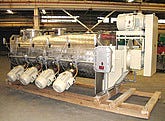Dry Neutralization of Detergents
February 8, 2011
|
Littleford FKM-3000-D (4z) showing the high-speed choppers. Unit is capable of 74-cu-ft batch sizes. |
Dry powdered detergent formulations are usually composed of a combination of ionic and/or non-ionic surfactants, builders (such as carbonates, phosphates, silicates, brightening agents, etc.) and inerts. These components are processed to form a dry powder product possessing desirable flow properties and appearance.
There are two generally accepted methods by which to arrive at the final product: one is a “wet” process and the other is a “dry” process.
In the wet formulation, the product of the sulfonation (a heavy liquid acid) is added to a caustic solution. The resulting surfactant is a slurry form. This slurry is homogenized with the other components of the mix in a vertical stirred tank. The resulting material is a heavy paste. The paste is pumped to a spray drying tower where the moisture is removed. The dry, low-density, hollow granules are collected at the bottom of the tower. This product may be packaged as is or may be processed further. Since the trend in the market today is towards densified detergents, the low-density product is often densified in additional equipment.
|
Littleford FKM-4200-D (4z) showing the high-speed choppers. Unit is capable of 104-cu-ft batch sizes. |
A popular alternative to the wet process is a dry-based process. In this method the surfactant is prepared by spraying the liquid acid onto sodium carbonate. This is known as dry neutralization. The resulting surfactant is a dry granular powder. The dry surfactant may then be blended with the other dry components of the mix. Since the resulting mix is dry, the costly spray drying operation is eliminated. A non-ionic surfactant is sometimes sprayed onto the product to enhance flowability and reduce dusting.
The manner in which the liquid acid is added to the sodium carbonate is critical. The acid must be added at a controlled rate and dispersed uniformly to avoid overwetting. Overwetting will result in large wet agglomerates containing unreacted material not suitable for use in the final blending operation. When processed properly, the product of the dry neutralization will be homogenous in composition and particle size.
Supplementary high speed impact choppers supply localized high shear fields required for the thorough dispersion of the acid. The choppers also aid in deagglomeration and densification of the product.
For more information, contact Littleford Day Inc., Florence, KY at 800-365-8555 or [email protected], or by visiting www.littleford.com.
You May Also Like




